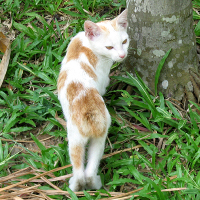 |
Japanese Bobtail |
|
TranslationFrancis Vandersteen |
||
OriginThe Japanese Bobtail is a breed of cat native to Japan. |
| This cat is characterized by its short, curled tail. |
A brief historical overview |
| The breed, when tortoiseshell and white, is known as the Mi-ké (three hairs = three colors) in its native Japan, where it is considered a symbol of friendship and good luck. Very popular, the breed is associated with the effigy of Maneki-neko, i.e. “the happy cat”, “the cat who calls” or “the cat who greets”, supposed to ward off misfortune and disease. Many Japanese temples and buildings feature a statuette of the maneki-neko at the entrance. The painter Hiroshige sometimes used it to symbolize the calm of large Japanese homes. The Bobtail owes its name to its short tail. The United States, where it is very popular, welcomed the first pair in 1968 and recognized the breed two years later. The breed was introduced to France by Hélène Choisnard. During a trip to Thailand in 1980, she visited a temple dedicated to Buddha, where a young tricolor female named Sirikit caught her eye. A monk offered her to him, and she gave birth to a litter a year later, Mme Choisnard having bred her to a Japanese Bobtail she had brought from the USA. The Bobtail is recognized by the LOOF, but the breed has had difficulty establishing itself in Europe, where it is often confused with another short-tailed cat breed, the Manx. |
Behavior / characteristics |
| Friendly and sociable. The Japanese Bobtail is said to be a loyal cat, following its owner wherever he goes. It also has a distinctive voice and sometimes holds “conversations” with its owners. However, these traits are entirely individual and depend on the history of each cat. |
Health |
| As this is a recent breed, there are no known congenital defects, unlike some older breeds. |
Head |
||
Cranial region |
||
Head |
The head is triangular. | |
Facial region |
||
Eyes |
The eyes are large and oval, slightly slanted, green or copper or blue, or pers eyes are highly sought-after. | |
Body |
||
Generality |
Despite its delicate, slender appearance, this is a medium-sized, well-muscled cat, whereas the Manx is stockier and has no tail. | |
Tail |
| The main characteristic of the Japanese Bobtail is its stumpy tail, which is carried erect when moving and folded at rest. The tail is made up of vertebrae fused together, the bony structure hidden by the long, shaggy hair that covers the tail. When unfolded, the tail can measure between 8 and 10 cm. It is often said to resemble a chrysanthemum flower. This is a genetic mutation that has been perfectly spontaneous among Southeast Asian cats for thousands of years, and does not harm the cat in any way. |
Limbs |
| The Japanese Bobtail's limbs are longer and thinner at the back and thinner at the front. The particularly acute angle of the hind legs gives them a horizontal profile. | ||
Forequarters |
Hindquarters |
Coat |
||
Coat and texture |
The coat is short, soft and silky, and very easy to care for. The most sought-after color is tortoiseshell (Miké), found only on females. A tricolored male is rare, and normally suffers from congenital deformities and is sterile. They can also be entirely white, black, red, black and white, red and white, tortoiseshell or tortoiseshell and cream. The original breed is the Japanese Bobtail, with short hair and two colors: black and white, red and white and, of course, tortoiseshell. There is also a semi-long-haired variety. The Japanese Bobtail remains a confidential breed in continental Europe. | |
Size and weight |






 English (United Kingdom)
English (United Kingdom)